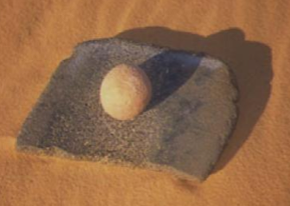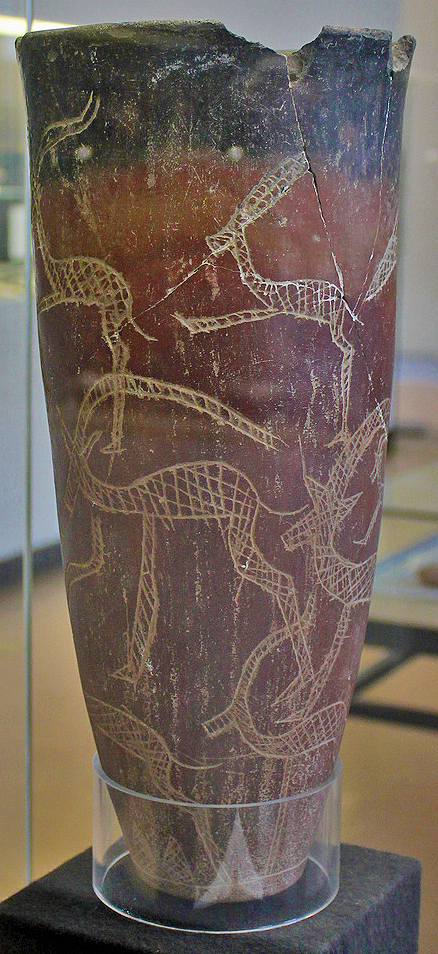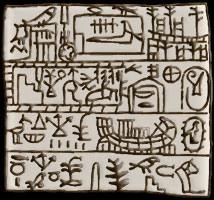| |
Predynastic Cultures of the Nile Valley |
|
This page added 10-30-2012
|
|
LAST UPDATE: 10-30-2012
|
|
|

The seven major oases of Egypt.
|
|
|

Demographic model for the Western Desert and the Nile
|
|
|

The Wadi Howar as seen from Gebel Nahas.
|
|
|

Early cattle remains from archaeological sites in the Wadi Howar and adding regions in the Sudan and southern Egypt.
|
|
|

Pottery such as this is associated both with ancient pastoralists and Late Palaeolithic hunters and gatherers.
|
|
|

Grindstones suitable for preparing wild grasses and seeds are a persistent feature of Later Palaeolithic and Epipalaeolithic tool kits.
|
|
|

Storage pots left at an Neolithic settlement abandoned as the climate became hotter and dryer.
|
|
|
LATER PALAEOLITHIC CULTURES ALONG THE NILE
|
| |
|
Lower Nubia
|
Upper Upper Egypt
|
|
Arkinian (10,600 BP)
|
|
|
|
Isnan (12,700-11,500 BP)
|
|
|
Afian (13,500-12,300 BP)
|
|
Qadan (14,500-12,000 BP)
|
|
|
Sebilian (ca. 14,000 BP)
|
Sebilian (ca. 14,000 BP)
|
|
Ballanan-Silsilian (16,000-15,000 BP)
|
Ballanan-Silsilian (16,000-15,000 BP)
|
|
|
Idfuan (17,500-17,000 BP)
|
|
Halfan (19,500-18,500 BP)
|
Kubbaniyan (19,000-16,500 BP)
|
|
|
Industry D (19,100 BP)
|
|
|
Fakhurian (21,000-19,500 BP)
|
|
Lower Egypt
None Formally
Described
North of Qena
|
|
|

Remember the part of the ancient Nile Delta that is now submerged beneath the Mediterranean Sea. The Nile below the First Cataract is graded to the sea. When sea level rose after the last ice age, the Nile aggraded its floodplain burying older archaeological sites. In fact, Late Palaeolithic sites are not found downstream from Qena, at the bend in the Nile north of Luxor.
|
|
|

Burials 20 and 21 from Site 117 near Jebel Sahaba, along the Nile near the Sudan border. This is a stone age, pre-agricultural site from about 11,500 BCE. 40% of the individuals in the cemetery died from wounds inflicted by weapons such as arrows and spears. Learn more about Site 117.
|
|
|

Here are some of the microlithic armatures found with the skeletons at Site 117 near Jebel Sahaba. These provided the sharp cutting edges and points of composite arrow points. From The Prehistory of Nubia, Vol. II 1968:894) by Fred Wendorf.
|
|
|

Microlithic armatures used in transverse arrows from the Predynastic site at Naga-ed-Der. From Ancient Egyptian Bows and Arrows and their relevance for African Prehistory, by Stanley, Phillips and Clark (Paleorient, 2:2:323-388, 1974).
|
|
|

Fragment of a commemorative pallet showing a man pierced by a transverse arrow. Predynastic, Naqada III.
|
|
|
 
A predynastic arrowhead with arrow poison on the foreshaft; Predynastic Sudan. Four bone points coated with arrow poison from Predynastic burials at Naga-ed-Der. From Ancient Egyptian Bows and Arrows and their relevance for African Prehistory, by Stanley, Phillips and Clark (Paleorient, 2:2:323-388, 1974).
|
|
|
 
Negada II engraved sherd from Gerzeh (left) and Neqada I sherd (right) with raised glyph.
|
|
|

Gerzeh Palette with Hathor's symbol. Naqada I.
|
|
|

Engraved vase. Naqada I.
|
|
|

Senet board and pieces. Naqada I.
|
|
|

Stone vase. Naqada III.
|
|
|

Cosmetic pallette. Naqada II or III.
|
|
|

Flint knife with ivory handle, Gebel el-Arak.
|
|
|
  
The tags of the first dynasties.
|
|
|

Scorpion palette. Naqada I.
|
|
|

Scorpion king opens an irrigation system.
|
|
|

Predynastic mace head. Notice the eyes. Naqada II.
|
|

